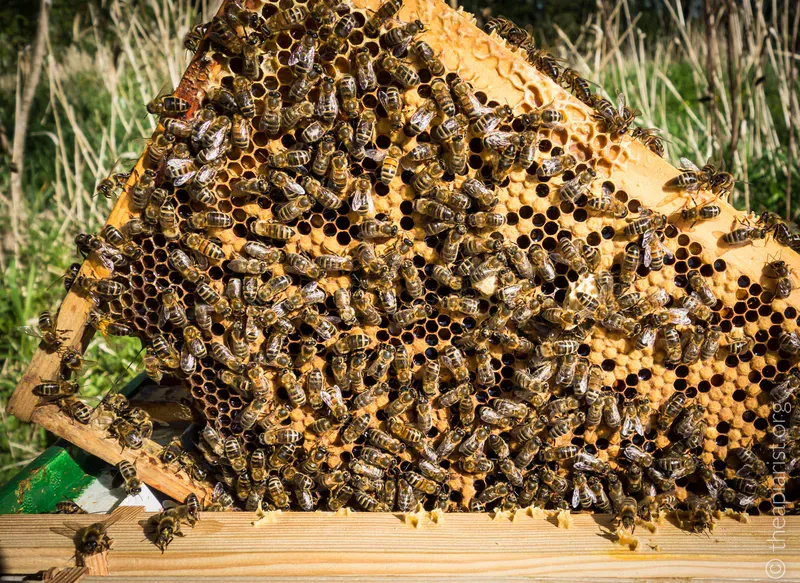Judgement Day

It's been said before that you cannot learn beekeeping from books. You can learn about beekeeping, but it's not the same as practical experience.
The implication that you might be able to learn it from a website (like this one) is also erroneous. You also can't learn it from YouTube, or TikTok, or Instagram — or, horror of horrors, Twitter {{1}}.
The reasons are many and varied.
Too small
The things you need to see are often far too small to meaningfully display. A still photo might be used to show a queen cell hidden, tucked away by the sidebar, out of sight and out of mind. But, getting the photo showing it (and how easy it is to miss) takes ages. I write from experience. Similar time needs to be invested in showing all the other, even less obvious, events.

Early signs of laying workers in the hive? Queenless, no brood (and definitely no open brood), and just a few cells scattered about with eggs adhering to the sidewalls.
Good luck with that.
Or is it a queen that's just started laying?
What about showing that in a video? Without the help of Attenborough's film crew, a decent macro lens, a sturdy tripod and some dazzling LED lighting, forget it.
A wobbly, focus-searching video of a frame held in part-shadow might accurately reproduce the experience of inspecting a colony, but it's not much use when it comes to demonstrating precisely what you are looking for.
And, if a picture is worth a thousand words, describing all that in text, whilst focussing on the important bits, can be convoluted and littered with caveats {{2}}.
A wiggling mass
A second reason is that, in the hive, everything moves.
Well, almost everything.
The exceptions are the things you really need to see which are hiding under a moving carpet of bees. Despite being pulled out of their dark, warm, pheromone-infused home, the bees on the frame usually continue busily antennating, trophallaxing, dancing, watching the dancers (or, more accurately, feeling and listening to them), fanning, grooming, and just ambling around doing stuff.
Or, ambling around doing nothing.
Other, that is, than obscuring your view.
This is one of the reasons why bees that run manically over the frame are much less pleasant — and much more difficult — to inspect than those that are calm and stable.
Your ability to see the things that really matters in the hive is much reduced.
The other of course is that those running bees tend to accumulate on the bottom corner of the frame, and then fall in a gloopy clump, almost invariably into the top of your boots.
All that movement makes creating even mediocre videos difficult, and also means that good still photographs risk over-simplifying the complexity of the subject.
The individual, the population, and the environment
And there's a third reason that 'time served' over an open hive is the best way (and possibly only way) to learn how to keep bees is the dynamic range of the exercise {{3}}.
Think about what a typical colony inspection involves:
- an appreciation of the weather — recent, current and future — all of which influence colony behaviour and performance (historical, current and future)
- the available local forage; what has flowered, what is flowering, and what should begin flowering in the days and weeks ahead
- the behaviour and demeanour of the colony; what are the bees doing at the hive entrance, how are you greeted by those on the top bars when you remove the crownboard? Are they defensive? More defensive than they usually are? Are they more defensive than they should be?
- the appearance and behaviour of individual bees in the colony; are those wobbly, shaking bees dancing, or showing early symptoms of a paralysis virus? Is the queen mated and confidently walking about her domain, or unmated and scuttling around the frame being harried by the workers?
- some basic maths; what are the proportions of sealed, open brood and eggs? Is the laying rate of the queen increasing, steady, or decreasing? How many frames of brood? Are there enough stores?
That lot encompasses everything from the local weather and pollen/nectar sources within ~3 miles, to the number and position of eggs within a cell.
A size range from the 'only just visible if I remember my glasses' to something that requires a map.
From micro to macro.
Don't let anyone tell you that's easy … or that a 5-minute reel on TikTok can show what's involved 😉.
And all that's before considering the bees pinging you, wiggling under the zip closure on your nape, or swaggering threateningly into your peripheral vision … inside the veil.
Judgement Day
But this post isn't about the difficulty of inspecting a colony per se, or even about learning how to inspect a colony from anything other than 'time served' over an open hive. Instead, it's about the decisions you make during those inspections after seeing the things you need to see.
Another layer of complexity.
This post is for subscribers to The Apiarist. Subscription is free, but you can also sign up as a sponsor and guarantee bee-related news, views, tips and tricks every week.